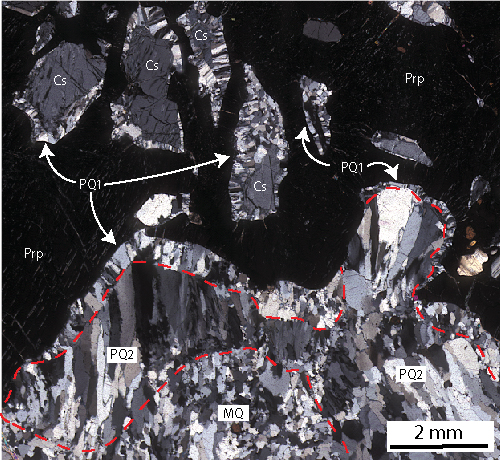In the last decade, studies of rifted margins have benefited from an increasing quantity of high-quality data from several disciplines. The Ivrea-Verbano Zone (IVZ), in the Italian Southern Alps, represents a complete section of middle to lower continental crust, which records both the Variscan and subsequent Alpine Tethys rift-related tectonics (Beltrando et al., 2015; Simonetti et al., 2023).
One of the most important structures is the Forno-Rosarolo shear zone (Siegesmund et al., 2008). It is a NE-SW-oriented, subvertical shear zone made of metapelites, amphibolites, calc-silicates and granulites involved in anastomosed proto- to ultra-mylonite layers enveloping weakly deformed lenses. Mylonites formation postdate Variscan metamorphism and deformation and predate Jurassic brittle fracturing and faulting.
In present day orientation, the kinematic indicators point to a sinistral sense of shear. Removing the Alpine tilt at high angle of the IVZ, this kinematic points to a former extensional shear zone. Investigations on the mylonitic flow kinematic reveal a non-coaxial deformation characterized by dominant pure shear (between 70 % and 50 %) and minor simple shear. Metamorphic conditions of the wall rocks vary from the upper amphibolite (SE, footwall) to the granulite facies (NW, hanging wall). Within the mylonites, PT estimate from mineral assemblage points to amphibolite facies conditions during deformation (~650 °C and ~5.5 kbar).
Such kinematic data and metamorphic conditions allow to constrain the development of the Forno-Rosarolo shear zone mylonitic deformation, together with other similar structures of the IVZ, during the intermediate phase of the Tethyan rift (Beltrando et al., 2015; Simonetti et al., 2023) known as “thinning mode” (Manatschal et al., 2007). This stage was characterized by general shear conditions (pure shear between 70 % and 50 %) suggesting a phase of transition from a symmetric to an asymmetric configuration of rift.
Beltrando M., Stockli D.F., Decarlis A., Manatschal G., 2015. A crustal‐scale view at rift localization along the fossil Adriatic margin of the Alpine Tethys preserved in NW Italy. Tectonics, 34, 1927–1951. https://doi.org/10.1002/2015TC003973
Manatschal G., Müntener O., Lavier L.L., Minshull T.A., Péron-Pinvidic G., 2007. Observations from the Alpine Tethys and Iberia–Newfoundland margins pertinent to the interpretation of continental breakup. Geol. Soc. Spec. Publ., 282, 291–324. https://doi.org/10.1144/SP282.14
Siegesmund S., Layer P., Dunkl I., Vollbrecht A., Steenken A., Wemmer K., Ahrendt H., 2008. Exhumation and deformation history of the lower crustal section of the Valstrona di Omegna in the Ivrea Zone, southern Alps. Geol. Soc. Spec. Publ., 298, 45–68. https://doi.org/10.1144/SP298.3
Simonetti M., Langone A., Bonazzi M., Corvò S., Maino M., 2023. Tectono-metamorphic evolution of a post-variscan mid-crustal shear zone in relation to the Tethyan rifting (Ivrea-Verbano Zone, Southern Alps). Journal of Structural Geology, 173, 104896. https://doi.org/10.1016/j.jsg.2023.104896

